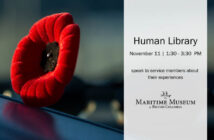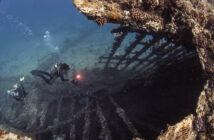The merchant ship HMS Investigator was acquired in 1848 to look for Sir John Franklin’s disastrous Northwest Passage expedition. She made two trips to the Arctic before being forced to be abandoned in 1853 when she got stuck in the pack ice. She was the fourth ship to carry the name in the Royal Navy.
The 422-ton Investigator, built by Scotts Shipbuilding and Engineering Company in Greenock on the Firth of Clyde, was bought by the Admiralty in February 1848 and modified by R. & H. Green at Blackwall Yard on the River Thames for arctic exploration. Woolwich Dockyard’s master shipwright William M. Rice strengthened her for use in the Arctic. She was heavily reinforced with 516 in (8 mm) steel plating and timber, including teak, English oak, and Canadian elm. Ten pairs of diagonal plates and ten pairs of wrought iron diagonal riders were installed on the sides of the ship between decks. The upper decks were doubled with 3 in (76 mm) fir planking to handle snow and ice loads. To enhance lighting and ventilation, Preston’s Patent Ventilating Illuminators were installed. A modern stove system designed by Charles Sylvester that could warm the entire ship was also used successfully. William Edward Parry had used a similar or identical device in 1821 to aerate the lowest deck and prevent condensation.
Career
Investigator travelled with HMS Enterprise on James Clark Ross’ search for Franklin’s missing expedition in 1848. Captain Robert McClure was in charge when they set out on their return trip, but at Mercy Bay, which is next to Banks Island, the ship got stuck in the pack ice.
She was unable to break free of the ice, leaving her crew stranded for two years before being rescued by the HMS Resolute, another British vessel. The crew of 66 went through unspeakable hardships during those two years. Many men suffered from scurvy and three of the 66 sailors died.
Investigator was abandoned after the crew was saved and left to sink to the bottom of the Beaufort Sea, where she remained until July 2010 with her secrets frozen in place. However, due to difficulties in accessing the area—which is extremely inhospitable and frequently iced over—her exact location was unknown for more than 150 years.
The circumstances surrounding Investigator’s abandonment are not a mystery, unlike the losses of Erebus and Terror. Alexander Armstrong, the ship’s physician, published an unofficial account of the voyage in 1857.
Inuit oral traditions contain tales about the ship. The local natives used the abandoned ship as a source of copper and iron; when smaller boats were found on the shore, metal nails were missing. According to an Inuit report from 1910, “one year she had still been on the beach and the next year she was gone without a trace.” During his Arctic expedition in 1915, Canadian anthropologist Vilhjalmur Stefansson reached Mercy Bay, but he was unable to locate her remains.
Discovery
A team of archaeologists, scientists, and surveyors from Parks Canada started looking for the Investigator’s sunken wreck in Mercy Bay at the park’s northernmost point in July 2010. The expedition was the first to look specifically for the ship. Based on the original Royal Navy records of the ship’s location when it was abandoned, the team reached Banks Island in the Beaufort Sea on July 22 and started a sonar scan of the region three days later. The ship’s deck was located about 8 meters (26 feet) below the surface, 150 meters (490 feet) off the north shore of Banks Island.
An official with Parks Canada stated that the ship was discovered “sitting upright in silt; the three masts have been removed, probably by ice.” Due to the chilly Arctic water, her hull is partially buried in silt, and the outer deck is not degrading as quickly. Although the team sent a remotely operated underwater vehicle to take pictures and assess the wreckage, there are no plans to raise the ship’s remains.
As a site for archeological and cultural heritage, Parks Canada acknowledges that Great Britain still has legal ownership of the HMS Investigator.








